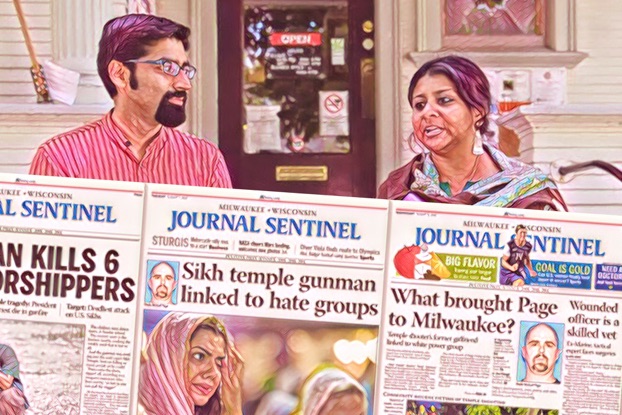
Where were you five years ago, on August 5, 2012?
From storytelling on the streets of Berkeley to the mass murder at the Oak Creek Gurdwara, it’s the fifth anniversary of a day I won’t easily forget.
I started the day feeling anxious. For years, my partner Barnali Ghosh and I had been collecting stories of Desi activists in our hometown of Berkeley, California. There were so many! Someone could even do a walking tour, we joked. And then we tried to make it happen.
We started pulling together stories of Berkeley’s South Asian activism. We found a striking photo of protesters in saris in The Karma of Brown Folk.
Barnali dove into UC Berkeley’s archives, discovering stories of Ghadar Party freedom fighters. I interviewed our friend “Tinku” Ali Ishtiaq, a Bangladeshi American activist I’d met during an anti-war protest. Barnali drew a map of Berkeley, and we marked points associated with each story, hoping to find a walkable path connecting them. Then we turned our research into a script, incorporating storytelling, visuals, and street theater.
“It’s the fifth anniversary of a day I won’t easily forget.”
On August 5, 2012, we tried running our very first Berkeley South Asian Radical History Walking Tour for the participants of Bay Area Solidarity Summer — emerging Desi activists ages 15–21. We gathered on Telegraph Avenue and began to walk, sharing stories of queer activism, student movements, and connections to non-Desi struggles. Along the way, we busted out some street theater to bring the stories alive. The young activists were loving it, and my nervousness slowly faded.
On the UC Berkeley campus, we told the story of Kartar Singh Sarabha, a young Sikh man who moved to Berkeley in 1912 hoping to study at the university, but ended up becoming a freedom fighter organizing Indian immigrants against British colonial rule. Barnali narrated, and I played the part of the young revolutionary who had walked the streets that we were walking today. By the time the story ended, we were both inspired and emotionally exhausted.
It was near the end of the tour when I saw one of the participants staring at her phone as we were about to cross the street. She showed me what she was looking at — a text from her mother saying something terrible was happening at a gurudwara in Wisconsin, and that she should stay safe. I took in the news and tried to project an air of calm. I assured her that it was fine, that we were all there together, and asked her to avoid sharing the bad news with others until after the tour had ended.
The last story on the tour, at Berkeley High School, was particularly difficult. First, we set the scene by asking participants to read excerpts from American Backlash, a report by SAALT documenting the wave of violent xenophobia that rocked our communities after 9/11. Then we told the story of post-9/11 backlash attacks at Berkeley High, and how a group of primarily Sikh and Muslim students built a multiracial coalition to take on hate and rebuild safety for impacted communities.
“Past and present were colliding.”
Past and present were colliding. I kept thinking of Sikh families under attack in a place of sanctuary, even as we were sharing stories of a century of Sikh American resistance to racism and colonialism.
The tour ended, and we returned back to camp. The Bay Area Solidarity Summer organizers shared the bad news with everyone, and made space for us to talk and mourn together.
We have run 120 more Berkeley South Asian Radical History Walking Tours since that terrible day in 2012. Over the past five years of historical storytelling, we’ve spent a lot of time thinking about how easy it is to frame the story of South Asian America to tell dramatically different narratives.
Some of us tell stories of South Asian success, of immigrant doctors and engineers, suburban homes and model minority dreams, spelling bee champions and brown faces in the White House. We worked hard, and the United States has come to love us.
Some of us tell stories of hatred, violence, and othering, starting with the enslavement of Mary Fisher around the 1690s, the Bellingham Riots, the Tide of Turbans, Dotbusters hate crimes, waves of backlash after 9/11, and anti-Muslim attacks in the age of Trump. The United States hates us, and all people of color.
“The stories we want to emphasize are about resilience, connection, solidarity, and agency.”
Both of these narratives are true, but for us, they’re just not helpful. We’re very open about our bias. The stories we want to emphasize are about resilience, connection, solidarity, and agency: Punjabi-Mexican and Black-Bengali families, immigrant doctors offering care in rural communities, Indian and Irish freedom fighters dreaming together of liberation, youth organizing against waves of hate, and suburban Desi feminists standing up to violence within their communities.
Five years after the Oak Creek shootings, we continue to mourn for Paramjit Kaur, Satwant Singh Kaleka, Prakash Singh, Sita Singh, Ranjit Singh, and Suveg Singh. But the story doesn’t end with victimization by a White nationalist.
In the wake of the violence, the families of Oak Creek counted their losses. They mourned. They rebuilt together. And they continued to stand against hate alongside their neighbors — a story told in Deepa Iyer’s We Too Sing America. Five years after the Oak Creek shooting, it’s these quiet acts of resilience and activism in the face of hate that stay with us. And as we decide how to tell the histories of our community, we hope these are the ones we will remember, retell, and build on.
This is cross-posted from SAALT’s Remember Oak Creek blog series.
* * *
Anirvan Chatterjee works with the Alliance of South Asians Taking Action and Bay Area Solidarity Summer. He and Barnali Ghosh curate the Berkeley South Asian Radical History Walking Tour.












